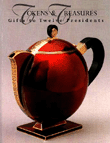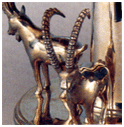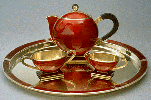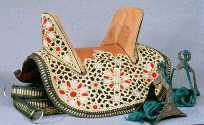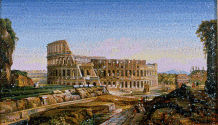|
Pedestal Bowl, ca. 1969, Gift to President
Nixon from Haile Selassie I, Emperor of Ethiopia. |
Gifts of State The exchange of gifts among kings and chiefs and presidents and premiers is a centuries-old tradition. From the ancient civilizations of Rome and Egypt to the native tribes of North America, ceremonial gifts have paved the way for peaceful coexistence between peoples of different cultures. They are universal symbols in the language of diplomacy.In 1787 a young America defied this old custom and banned the acceptance of foreign gifts by government officials. For citizens of a new democracy, gifts bore both the distasteful odor of aristocracy and the distinct scent of danger: A bribe in betrayers' hands could topple a government. In spite of the prohibition, the strong tradition of diplomatic exchange compelled foreign leaders to continue to send gifts. Refusing them proved impossible; it was at best impolite and at worst a stinging offense. Despite early ideals, Presidents often had no choice but to accept foreign gifts; indeed, every President since George Washington has received gifts of state. Today gift-giving between heads of state is an important part of modern-day international relations. U.S. Presidents routinely meet face to face with leaders from every corner of the earth. These state visits shimmer with pomp and ceremony, including formal welcomes, elaborate dinners, and the exchange of gifts. As tokens of this ritual of diplomacy, gifts are enduring emblems of international cooperation and friendship. Though gifts from foreign leaders bear a symbolic meaning, they also resonate with the variety and vibrancy of all the nations of the world. They range from native arts or antiques-prized pieces of a country's culture and heritage–to sparkling gold and gemstones. Other gifts are surprisingly sentimental, symbols of national or personal friendship. All enrich the relations between two countries and their leaders. And each recalls a moment in history, when two nations–often separated by oceans or ideology–briefly clasped hands.
|
||
|
Tea set, by David Andersen, Oslo,
Norway, ca. 1930s |
In April 1939 the Crown Prince and Princess of Norway visited President and Mrs. Roosevelt at the Roosevelt family home at Hyde Park, New York. Treated to tea, a recital by local Norwegian Americans, and a picnic in the rolling countryside of the Hudson River Valley, the royal couple was enchanted by their visit. They sent the Roosevelts this Art Deco-style tea set as a remembrance.
|
||
|
Adoration of the Three Wise Kings, ca. 1500 |
When he visited the United States in 1956, Chancellor Adenauer gave this painting by a Southeast German master to the President. The two leaders discussed the progress of rebuilding postwar West Germany.
|
||
|
Cloisonné liqueur set |
In May 1972 the two leaders of the world's most powerful countries met to sign the Strategic Arms Limitation Talks (SALT) agreement. By restricting missile production in the United States and the Soviet Union, Nixon and Brezhnev hoped to reduce the threat of war between the two nations. Cloisonné, a difficult technique of soldering and enamel painting–and a specialty of Russian craftsman–is a favorite gift of Russian leaders.
|
||
|
Water or wine vessel, Roman, first or second century |
Roman forces occupied present-day Israel from about 60 B.C. to 600 A.D. Many hundreds of years later, this remarkably preserved remnant of Israeli history became a gift to an American President.
|
||
|
Great Order of the Nile |
President Jimmy Carter helped to negotiate peace between Egypt and Israel after 31 years of war. When Carter visited Egypt in 1979, President Sadat, by then a good friend, presented Carter with this gift, Egypt's highest honor.
|
||
|
Saddle |
Because of his love for riding, President Reagan received dozens of saddles from both the general public and foreign leaders. President Bendjedid presented this richly embroidered saddle during an official state visit in April 1985.
|
||
|
The Roman Coliseum |
In June 1994 President Clinton traveled to the Vatican for a private audience with the Pope. During their meeting, the leaders discussed the cause of religious freedom, world population growth, and the role of family in society. His Holiness also gave the President this intricate and unusual glass mosaic.
|
||

